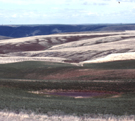Large Variations in Southern Hemisphere Biomass Burning During the Last 650 Years
Z. Wang, J. Chappellaz, K. Park, and J. E. Mak. 2010. Large Variations in Southern Hemisphere Biomass Burning During the Last 650 Years. Science Express 2 December 2010.
Full text [here]
Selected excerpts:
Abstract
We present a 650-year Antarctic ice core record of concentration and isotopic ratios (d13C and d18O) of atmospheric carbon monoxide. Concentrations decreased by ~25% (14 ppbv) from mid-1300s to the 1600s, then recovered completely by the late 1800s. d13C and d18O decreased by about 2% and 4% respectively from the mid-1300s to the 1600s, then increased by about 2.5% and 4% by the late 1800s. These observations and isotope mass balance model results imply that large variations in the degree of biomass burning in the Southern Hemisphere occurred during the last 650 years, with a decrease by about 50% in the 1600s, an increase of about 100% by the late 1800s, and another decrease by about 70% from the late 1800s to present day.
… The main sources of atmospheric CO include atmospheric oxidation of methane and non-methane hydrocarbons (NMHC), biomass burning, and fossil fuel combustion (4). These sources account for about 90% of today’s global CO budget (4). Stable isotopic ratios (d13C and d18O) in atmospheric CO help to resolve the relative contributions of these sources and thus to better estimate the global CO budget (5). To date, no isotopic ratios from CO in ice have been reported and few CO mixing ratio measurements have been reported (1, 3, 6). Using a recently developed analytical technique (7), we present measurements of CO concentration ([CO]), d13C, and d18O from a South Pole ice core… and from the D47 ice core… in Antarctica (Fig. 1). …
The contribution from fossil fuel combustion is negligible prior to the 1900s based on historic CO2 emissions from fossil fuel combustion (10). In addition, simulations from the Model for Ozone and Related chemical Tracers (MOZART-4) (see Supporting Online Material, SOM) shows the fossil fuel combustion contribution to today’s CO budget in Antarctica is only 2-3 ppbv. Thus the main sources of CO able to explain our signals are biomass burning and NMHC oxidation. …
We can use isotopic compositions to help distinguish combustion-derived CO (e.g., biomass burning) from non-combustion derived CO (e.g., hydrocarbon oxidation). C18O is a useful tracer for this because of large differences in the oxygen isotopic composition between combustion and noncombustion sources of CO (11). The d18O signature from combustion sources is significantly enriched compared to the d18O signature from hydrocarbon oxidation processes (11-12). d18O value for biomass burning derived CO is generally between 15% and 22%, depending on specific combustion conditions (12–14). …
CO from NMHC oxidation did not change significantly, whereas CO from biomass burning showed a large “saddle” trend, with maxima in both the mid-1300s and the late 1800s and a minimum in the 1600s. The observed trend in [CO], d13C and d18O was therefore mostly driven by variations in biomass burning, and compared to present day, biomass burning was almost the same in the late 1800s as that in the mid-1300s. …
Previous modeling studies suggest that preindustrial biomass burning was much lower than today, with a reduction of up to 90% (35–37). This is the common assumption in climate model simulations. However, our results show that present day CO from Southern Hemisphere biomass burning is lower than at any other time during the last 650 years. This is particularly relevant since assumptions on preindustrial [CO] are an important component for correctly estimating the radiative forcing of tropospheric ozone in preindustrial times (38). [CO] changes due to biomass burning also suggest that there were decadal and centennial scale variations in average concentrations of black carbon, another major atmospheric constituent produced with burning, leading to the unanswered question of its potential role in long term climate variability.
